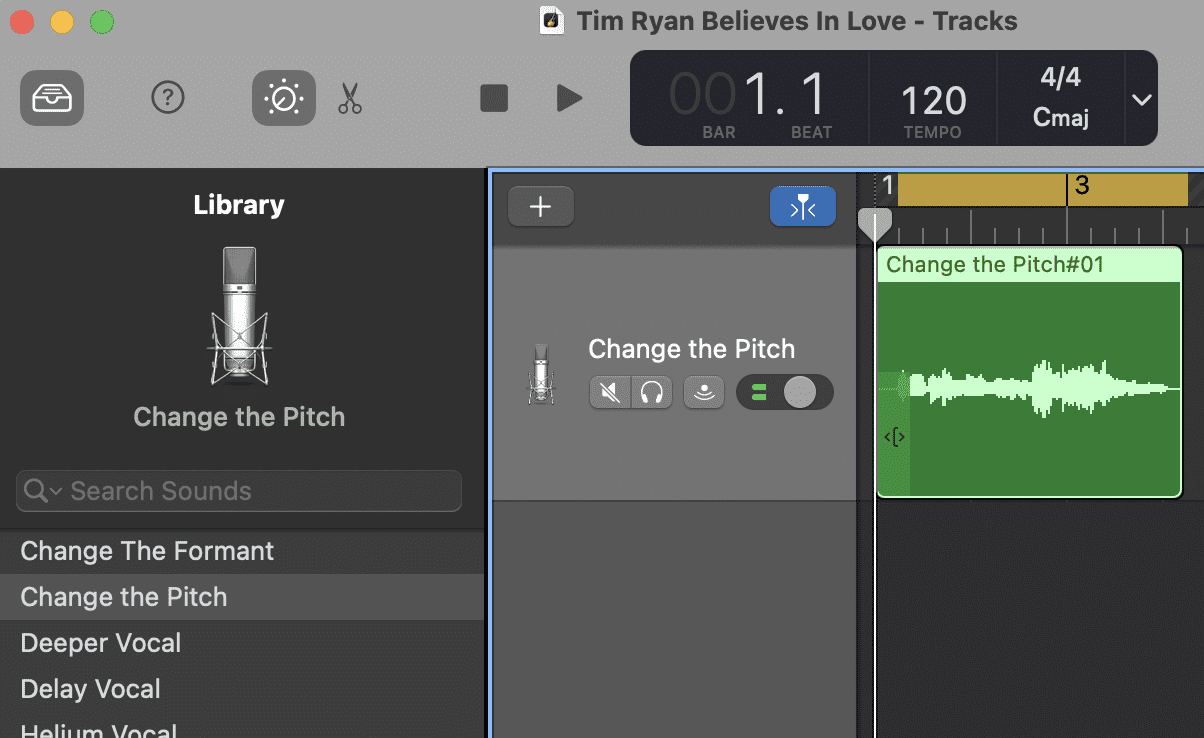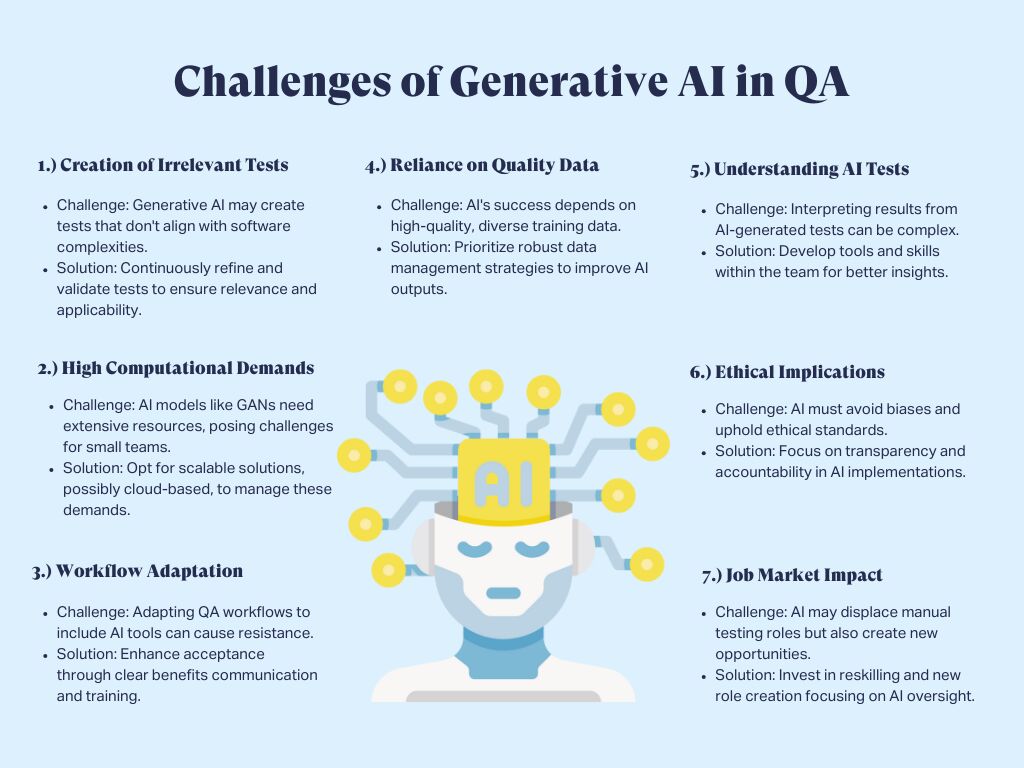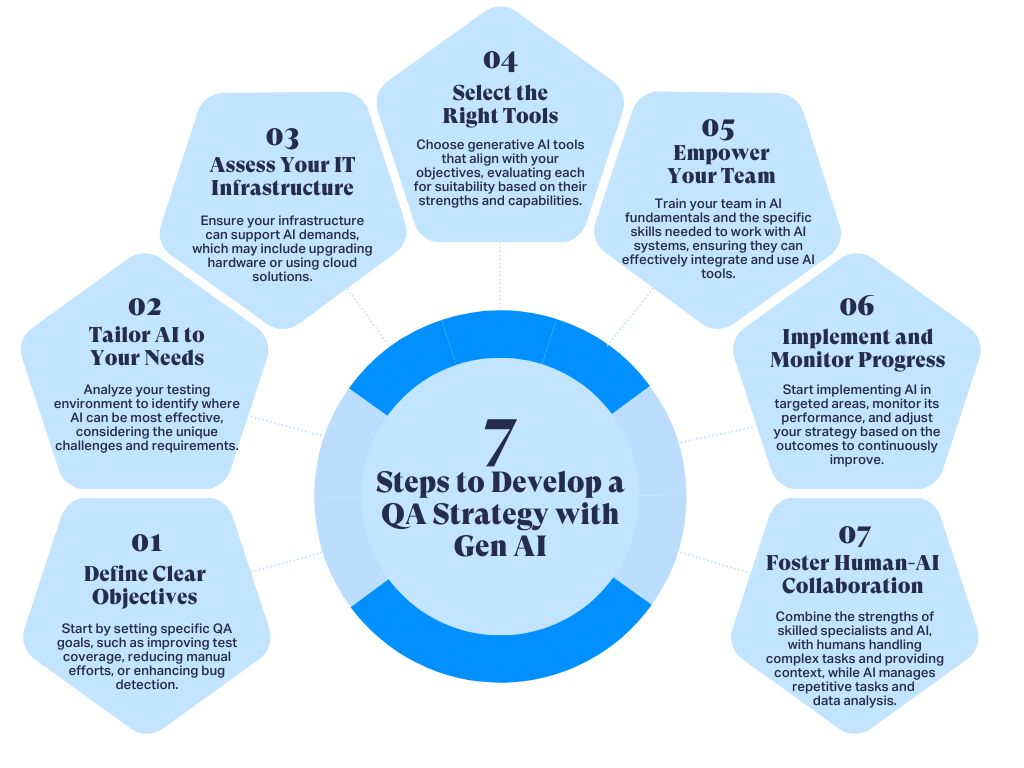Generative AI in Software Testing
Generative AI stands out for its ability to automate repetitive tasks and generate data-driven insights, significantly reducing manual effort and speeding up testing processes.

According to the LamdaTest Survey Report, 29.9% of professionals believe AI can boost QA productivity, while 20.6% expect it will make testing more efficient. Moreover, 25.6% believe AI effectively bridges the gap between manual and automated testing.
This article describes generative AI in software testing, along with challenges, tools, QA strategies, and the future. In this article, we will cover:
Table of Contents
- What is Generative AI in Software Testing?
- How Does Generative AI Improve Software Testing Efficiency?
- Challenges of Generative AI in QA
- Generative AI Testing Tools
- Developing a QA Strategy with Gen AI
- Future Of Generative AI in Testing
- Final Thoughts
What is Generative AI in Software Testing?
Generative AI in software testing is an advanced approach that augments human testers to make the testing process faster and more efficient while improving the quality of the software test results.
At Testlio, as a QA software testing company, we use artificial intelligence to assist expert QA testing managers in new test creation, faster test case refactoring, and creating issue reports with significantly fewer errors. In essence, AI testing tools help enhance human performance.
To better understand the concept of AI and testing, let’s talk analogies. What else comes to mind when comparing the idea of generative AI to other advances in human performance?
Did you say, Cher? Amazing, because that’s what we were thinking too.
In 1998, Cher leveraged a novel way to alter her voice in her song “Believe.” She used auto-tune technology, and Lil Wayne and many others soon followed. Auto-tune is an excellent analogy for how generative AI enhances the work of software testers. As auto-tune leverages technology to measure and improve pitch in vocal recording, generative AI in quality assurance enhances productivity, speed, and accuracy.
If you feel adventurous, have a listen to an a/b test using a basic pitch change filter to alter my version of Believe.

Taking the analogy a step further, think about other ways technology augments our ability to improve performance. Examples include Power Steering, the Jackhammer, Microsoft Excel, and Google Docs.
Or, take Grammarly’s editing tool. It identifies issues and helps improve writing accuracy and editing speed. Kind of like “AI QA” for writing.
Or Adobe Photoshop. It empowers a photo editor to enhance images, allows corrections, and, with generative AI, uses text prompts to add new images. None of this could happen in a traditional darkroom.

How Does Generative AI Improve Software Testing Efficiency?
Analysts estimate software testing costs companies ~$45B per year, with spending expected to grow 5% annually. With new AI testing tools, companies can expand their software testing coverage and gain even more confidence in the quality of their product releases.
For Testlio, generative AI significantly reduces manual effort, speeds up testing processes, increases testing coverage, and ultimately improves the overall quality of the software product.
Challenges of Generative AI in QA
Although generative AI in software testing offers many benefits, it also brings several challenges. It’s important to address these considerations through effective solutions. The challenges of gen AI in QA are:

1. Creating Useless Tests
AI can sometimes generate tests that are irrelevant or useless due to its limited understanding of context and complexity. Therefore, it is important to constantly refine and validate the generated tests.
2. High Computational Demands
Models like GANs (Generative Adversarial Networks) and transformers require a lot of computing power.
This can be a real problem for smaller organizations. To make AI work, it needs to be balanced with infrastructure availability.
3. Workflow Adaptation
Traditional QA workflows need to be changed to incorporate generative AI. AI-based tools may require training, and there may be resistance to change.
To overcome this resistance, you must clearly communicate the benefits and provide proper training and support.
4. Reliance on Quality Data
Generative AI depends heavily on the quality and diversity of the training data. Poor or biased data can lead to inaccurate or ineffective tests. Therefore, it is crucial that datasets are of high quality and representative for reliable AI performance.
5. Understanding AI-Generated Tests
Often, AI-generated tests are hard to interpret and understand, especially when they fail. Several additional tools or skills may be required to analyze the AI’s output effectively and ensure that actionable insights are generated.
6. Ethical Implications
The use of generative AI in software testing is subject to a number of ethical considerations. AI models should not contribute to harmful biases or make unethical decisions. To build trust in AI-driven processes, transparency, fairness, and accountability must be prioritized.
7. Job Market Impact
The introduction of generative AI in software testing can impact jobs within the QA industry. Although AI can automate repetitive tasks and improve efficiency, it can also replace manual testing jobs. It can, however, create opportunities for roles that require AI expertise and oversight, emphasizing the need for reskilling.
Generative AI Testing Tools
As a QA testing company, Testlio integrates generative AI testing tools and systems into key workflows within its manual and automated software testing platform, using client data sets in a secure and privacy-protected manner.
We’ve quickly learned that the optimal utilization of AI in quality assurance is to follow a human-AI collaborative approach with skilled specialists providing context, judgment, and handling complex tasks. And AI tackling repetitive tasks and generating data-driven insights within seconds.
Here is an overview of some of the popular AI-powered testing tools optimized for test automation:
- Testim: Uses machine learning to create, execute, and maintain automated tests, adapting to UI changes, ideal for dynamic platforms.
- Applitools: Specializes in visual testing, using AI to detect visual bugs across different devices, providing a consistent user experience.
- Functionize: Combines AI and natural language processing to automate test creation and maintenance, making testing easier.
- Mabl: Integrates AI throughout the testing lifecycle, allowing tests to adapt automatically to application changes.
- Test.ai: Automates mobile app testing using simulated user interactions to validate app functionality.
- Sauce Labs: Provides a cloud-based platform for automated testing across browsers and devices, using AI to optimize test execution and analytics.
- Code Intelligence: Offers AI-driven security testing with white-box fuzz testing to uncover bugs and vulnerabilities
Developing a QA Strategy with Gen AI
Your quality assurance (QA) strategy can be significantly improved by incorporating generative AI. You can follow this detailed strategy to help your organization through this transition:

1. Define Clear Objectives
The first step to QA success is to define your goals clearly. Identify your objectives, whether it is to increase test coverage, reduce manual testing efforts, improve bug detection, or all of these at once. Your strategy will be more aligned and successful if you set clear goals.
2. Tailor AI to Your Needs
Generative AI will not benefit every application or software equally. Consider the unique challenges and specifics of your specific testing environment. Identify the areas where generative AI can have the greatest impact.
3. Assess Your IT Infrastructure
Generative AI requires a significant amount of computational power. Your current infrastructure must be able to support AI requirements. For this purpose, you might need to upgrade your hardware or explore cloud-based solutions.
4. Select the Right Tools
There are various generative AI models and tools available, each with its strengths and weaknesses. Identify your objectives and testing needs before evaluating these options. Choose tools that will fit your QA strategy and meet your specific requirements.
5. Empower Your Team
Generative AI relies on your team’s skills to work effectively with AI systems. Provide training on AI fundamentals, interpreting AI-generated test results, and troubleshooting. Your team needs the right knowledge for integration to be successful.
6. Implement and Monitor Progress
Once your goals are set and your team is equipped, start implementing generative AI testing. Consider starting small and gradually expanding its use. Keep an eye on AI’s performance in your testing process to make sure it’s meeting your goals. These assessments will help you adjust your strategy.
7. Promote Human-AI Collaboration
Implement a human-AI collaborative model where skilled specialists provide context, judgment, and handle complex tasks, while AI handles repetitive tasks and generates data-driven insights. In this way, both human expertise and AI capabilities are combined in the testing process.
Future Of Generative AI in Testing
When it comes to the future, Testlio is backing Generative AI tools since Testlio’s initial experiments showed that:
- Testing managers using generative AI-assisted tools could refactor test cases 15-30% faster than traditional methods.
- Bug reports created by skilled QA testers using generative AI tools exhibited a 40%+ decrease in errors compared to reports generated through traditional methods.
The impact of these findings is significant for the software testing industry and a catalyst for change in software testing services.
To learn more about generative AI in software testing, read the results of Testlio’s initial studies published in 2023.
Final Thoughts
Generative AI in software testing is making humans more efficient and improving software quality. While generative AI offers many benefits, it also presents challenges such as creating irrelevant tests and high computational demands.
At Testlio, we address these by combining AI with human expertise, ensuring high-quality, secure, and efficient testing processes. We use AI to assist our QA managers in creating new tests, refactoring test cases faster, and generating more accurate issue reports.

Ready to improve your software testing with generative AI? Contact us to learn how we can help.
